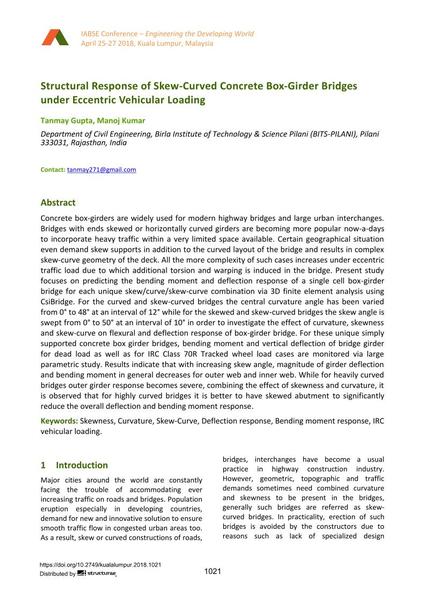Structural Response of Skew-Curved Concrete Box-Girder Bridges under Eccentric Vehicular Loading

|
|
|||||||||||
Bibliographic Details
| Author(s): |
Tanmay Gupta
(Department of Civil Engineering, Birla Institute of Technology & Science Pilani (BITS-PILANI), Pilani 333031, Rajasthan, India)
Manoj Kumar (Department of Civil Engineering, Birla Institute of Technology & Science Pilani (BITS-PILANI), Pilani 333031, Rajasthan, India) |
||||
|---|---|---|---|---|---|
| Medium: | conference paper | ||||
| Language(s): | English | ||||
| Conference: | IABSE Conference: Engineering the Developing World, Kuala Lumpur, Malaysia, 25-27 April 2018 | ||||
| Published in: | IABSE Conference Kuala Lumpur 2018 | ||||
|
|||||
| Page(s): | 1021-1028 | ||||
| Total no. of pages: | 8 | ||||
| DOI: | 10.2749/kualalumpur.2018.1021 | ||||
| Abstract: |
Concrete box-girders are widely used for modern highway bridges and large urban interchanges. Bridges with ends skewed or horizontally curved girders are becoming more popular now-a-days to incorporate heavy traffic within a very limited space available. Certain geographical situation even demand skew supports in addition to the curved layout of the bridge and results in complex skew-curve geometry of the deck. All the more complexity of such cases increases under eccentric traffic load due to which additional torsion and warping is induced in the bridge. Present study focuses on predicting the bending moment and deflection response of a single cell box-girder bridge for each unique skew/curve/skew-curve combination via 3D finite element analysis using CsiBridge. For the curved and skew-curved bridges the central curvature angle has been varied from 0° to 48° at an interval of 12° while for the skewed and skew-curved bridges the skew angle is swept from 0° to 50° at an interval of 10° in order to investigate the effect of curvature, skewness and skew-curve on flexural and deflection response of box-girder bridge. For these unique simply supported concrete box girder bridges, bending moment and vertical deflection of bridge girder for dead load as well as for IRC Class 70R Tracked wheel load cases are monitored via large parametric study. Results indicate that with increasing skew angle, magnitude of girder deflection and bending moment in general decreases for outer web and inner web. While for heavily curved bridges outer girder response becomes severe, combining the effect of skewness and curvature, it is observed that for highly curved bridges it is better to have skewed abutment to significantly reduce the overall deflection and bending moment response. |
||||
| Keywords: |
curvature Skewness Skew-Curve Deflection response Bending moment response IRC vehicular loading
|
||||
